A 78 per cent tax on fossil fuel companies in Australia is not required to fund a Just Transition away from carbon
As I noted yesterday, last evening I accepted an invitation to speak on a panel at a – Rising Tide – event, which is part of the massive – People’s Blockade – of the port of Newcastle that is running from November 19-24, 2024. The Blockade is a threat to the mining corporations and the NSW State Government has introduced pernicious regulative structures in the last week to make it illegal to venture in into the shipping channel to block the coal ships. Heavy fines and an aggressive police force are waiting for any activist who tries. It is an extraordinary overreach by government, who are clearly siding with these corporations. The discussion last night was interesting if only to confirm that this important group of activists have been channelled by poor advice into adopting mainstream macroeconomic frames, which make it very hard for it to broaden its appeal to the rest of the population. Here is my advice to them which will allow them to break out of that straitjacket and become an important educative vehicle for the climate movement.
